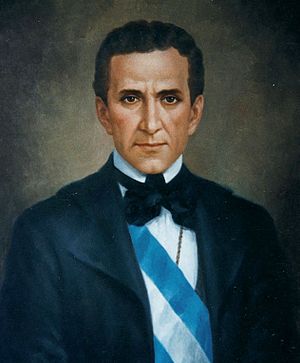José Joaquín de Olmedo facts for kids
Quick facts for kids
José Joaquín de Olmedo
|
|
|---|---|
 |
|
| Head of Provisional Government of Ecuador | |
| In office 6 March 1845 – 8 December 1845 |
|
| Vice President | Pablo Merino |
| Preceded by | Juan José Flores (as President of Ecuador) |
| Succeeded by | Vicente Ramón Roca (as President of Ecuador) |
| Vice President of Ecuador | |
| In office 12 September 1830 – 15 September 1831 |
|
| President | Juan José Flores |
| Preceded by | Position created |
| Succeeded by | José Modesto Larrea |
| Personal details | |
| Born | 20 March 1780 Guayaquil, Ecuador |
| Died | 19 February 1847 (aged 66) Guayaquil, Ecuador |
| Spouse | María Rosa Icaza y Silva |
| Alma mater | Universidad Mayor de San Marcos |
| Signature | |
José Joaquín de Olmedo y Maruri (born March 20, 1780 – died February 19, 1847) was an important leader in Ecuador. He was a President for a short time, from March to December 1845. He was also a famous writer and poet. His father was a Spanish captain, and his mother was from Guayaquil.
José Joaquín de Olmedo's Life
On October 9, 1820, Olmedo and other brave people declared Guayaquil independent from Spain. He became the leader of the Free Province of Guayaquil. However, Simón Bolívar later joined Guayaquil with Gran Colombia. Olmedo did not agree with this decision. He also served as the mayor of Guayaquil two times.
After Guayaquil joined Gran Colombia, Olmedo went to Peru. He became involved in Peruvian politics. He was part of Peru's first Congress and worked as a diplomat in Europe. He served as a minister in countries like France and Portugal.
He was the Vice President of Ecuador from 1830 to 1831. Later, he became the President of Ecuador in 1845. During his time as president, someone tried to overthrow him, but he survived the attempt.
Olmedo was also a well-known poet. His poems often focused on patriotic themes, celebrating his country. His most famous poem is La victoria de Junin. It talks about the Latin American fighters for independence. He saw them as the rightful heirs of the Incas.
Olmedo dedicated his life to Guayaquil. He helped create the city's flag and shield. In 1821, he wrote the Song to the October Ninth. This song later became the official anthem of Guayaquil.
He once said, "He who does not hope to win has already lost." This shows his strong belief in hope and determination.
Today, the main airport in Guayaquil is named after him: the José Joaquín de Olmedo International Airport.
Guayaquil's Independence
José Joaquín de Olmedo was part of a group that wanted Guayaquil to be free from Spain. This group was led by José de Antepara. They met secretly on October 1, 1820, at José de Villamil's house. They pretended it was a quinceañera party for Isabela Morlás.
Many people were there, including Gregorio Escobedo, Francisco de Paula Lavayen, and Luis Fernando Vivero. Some Venezuelans like Febres Cordero and Luis Urdaneta also joined. This group was known as the "Forge of Vulcan." At the end of the meeting, everyone promised to support the cause of independence.
In the days that followed, Antepara and Villamil convinced military leaders in Guayaquil to join them. They decided that Olmedo should lead the independence movement. On October 3, Villamil asked Olmedo to be the leader. Olmedo said no because he thought a military person should lead. However, he promised to help with political and diplomatic matters once Guayaquil was free.
The independence movement continued with careful planning. León de Febres Cordero eventually led the military side. They wanted to free the city with as little fighting as possible. On the night of October 8, the revolution began. Rebels captured military posts and arrested Spanish officials. The rebellion continued until the morning of October 9, when Guayaquil became independent.
Olmedo's Writings
José Joaquín de Olmedo spent part of his life writing. He created novels, songs, and poems. Some of his most famous works include:
- Canto a Bolívar (Song to Bolívar)
- Al General Flores, vencedor en Miñarica (To General Flores, victor at Miñarica)
- Alfabeto para un niño (Alphabet for a Child)
He also designed the flag and crest of Guayaquil. He wrote the words for its anthem, Canción al 9 de octubre. This song is considered the first anthem of the Ecuadorian territory.
In 1808, he wrote the introduction to a play called El Duque de Viseo de Quintana. He also started his poem El Árbol (The Tree) in 1808 and finished it in 1809.
In 1823, in Lima, he published his translation of Essay on Man by Alexander Pope. He translated it from English.
Later, in 1825, he wrote a song called Marcha and a poem named La Libertad (Liberty).
In 1837, he composed Canción del 10 de agosto. This song was an early version of Ecuador's current national anthem, Salve, Oh Patria.
His poems became very popular. In 1848, a collection of his poems called Obras Poéticas was published in Valparaiso. This happened just months after he passed away. A second edition was published in Paris in 1853. Many other versions have been published since then.
See also
 In Spanish: José Joaquín de Olmedo para niños
In Spanish: José Joaquín de Olmedo para niños

